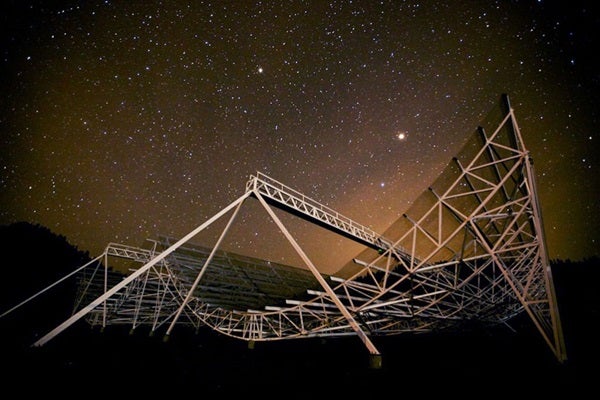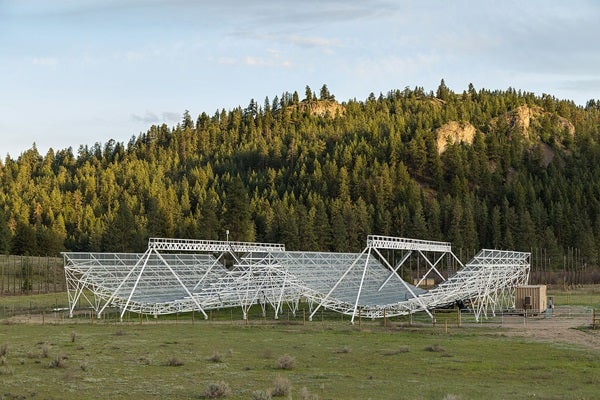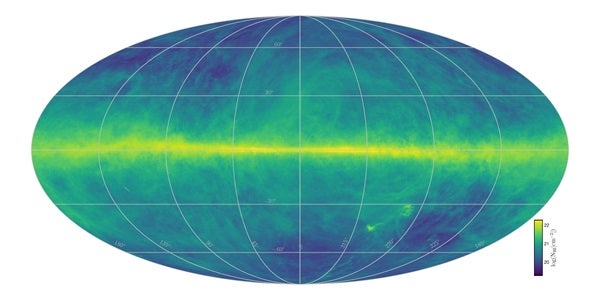“This telescope is radically different from other telescopes,” says Matt Dobbs, Associate Professor of Physics at McGill University and a CHIME investigator. “CHIME is really a stepping stone to a new way of doing radio astronomy.”
A new approach
The radio telescope – Canada’s biggest – is a joint venture co-led by the University of British Columbia, the University of Toronto, McGill University and the Dominion Radio Astrophysical Observatory (DRAO). Participating institutions come from across North America.
CHIME is a digital telescope, which means all of its “imaging” is done digitally by software. It accomplishes this with commercial components: Amplifiers developed for cell phones and graphics cards developed for video game systems power an instrument that cost only $13 million USD ($16 million CAD) to build. General-purpose, programmable computing hardware like this also gives CHIME the flexibility to explore three frontiers of modern astronomy: dark energy, pulsars, and fast radio bursts (FRBs).
CHIME is also a drift scan telescope with no moving parts. The instrument passively scans the entire Northern Hemisphere sky each day as Earth rotates. Its sensors consist of four 66 x 328-foot (20 x 100 meters) mesh reflectors, each shaped like a snowboard halfpipe. The focal axis of each reflector is lined with 256 dual-polarization antennas. Inputs from all of these antennas are combined, making CHIME the largest custom correlator in the world (correlators combine and enhance weak radio signals to prevent them from being lost against the background noise). CHIME’s location enhances its performance, as well. The DRAO site where CHIME operates is protected from radio frequency interference by the surrounding hills and by Canadian legislation.
The telescope processes data in two stages. Analog signals are first digitized by the telescope’s “F-Engine,” which organizes the data received by frequency. This information is then sent to an “X-Engine” for spatial analysis to essentially recreate an image of the sky. Data processing loads are heavy; the digitization engine must process 13-14 terabits per second – a rate equivalent to all the world’s mobile data network traffic.
Modeling dark energy
Questions about dark energy drove the initial design for CHIME. Astronomers have proposed dark energy as the force responsible for the increasing rate of expansion of the universe. CHIME scientists will use the telescope to map the largest volume of space ever surveyed to better characterize this expansion and to more accurately model the action of dark energy.
The team plans to study the distribution of neutral hydrogen (hence the “hydrogen intensity” in the CHIME acronym) structured by baryon acoustic oscillations (BAOs), which are spherical shells of matter with higher density than their surroundings. They were caused by sound waves throughout the early universe.
“These acoustic oscillations ran for a few hundred thousand years in the very early universe,” says Mark Halpern, Professor of Physics and Astronomy at the University of British Columbia and a CHIME investigator. “They left spherical shells of about four hundred million light years in diameter, a size that we know and understand.” These structures, therefore, can provide a “standard ruler” for distances.
“We’re comparing the distances we infer from the size of these spheres [near ones bigger, far ones smaller] with the distances we calculate from their redshift velocities to give us an expansion history,” says Halpern. And the outcome of that comparison could mean a lot. “A smoothly accelerating universe would yield a graph of a particular shape. Other models of cosmic acceleration would yield other shapes.”
Although BAO scales have been observed in the past, it has been via indirect measurements of the distributions of faraway galaxies, a challenging and painstaking process. The CHIME hydrogen intensity approach will be establishing new science by observing BAOs faster and at higher resolution. CHIME’s measurements will also rely on less complicated physics, simplifying the process for better results. “When we make that first measurement and we see the BAOs and characterize their scale,” says Dobbs, “we’ll have done the first measurement of a direct signal with 21-centimeter intensity mapping ever.”
Three telescopes for the price of one
Additional uses for the telescope were identified early in its development. “It was actually an historical accident,” says Dobbs. “The telescope and cosmology team was already in the midst of constructing CHIME when the topic of fast radio bursts became hot. While interacting with the FRB community, however, particularly at CIfAR (Canadian Institute for Advanced Research) meetings, we realized that we had the world’s best instrument already designed to detect them. So, we partnered with world leaders in fast radio bursts and put in a new grant request to build the FRB back end.”
With these new back end instruments, the telescope will study fast radio bursts (FRBs) and pulsars. Fast radio bursts are emissions lasting only milliseconds. Astronomers theorize that they’re caused by rapidly spinning neutron stars or black holes, but they remain poorly understood. While only a few dozen have been discovered so far (including one repeating FRB), some astronomers believe that up to 10,000 bursts might be occurring each day across the entire sky – but no telescope can currently track such a wide expanse. CHIME, however, can provide the kind of comprehensive, persistent gaze needed to characterize FRB distributions and behavior.
Animation illustrating the random appearance of Fast Radio Bursts on the sky. from NRAO Outreach on Vimeo.
T. Jarrett (IPAC/Caltech); B. Saxton, NRAO/AUI/NSF
The frequency components of radio pulses like FRBs can “disperse,” traveling at different speeds as they move through the interstellar medium. Brief pulses of only a single millisecond at their source can be stretched slightly by the time they reach a radio telescope. CHIME processing has the capability to reconstruct the original signal shapes, however, which means that the telescope can better localize the source of each FRB.
CHIME data are first organized by its main processing engines and sent to the FRB back end instrument. Candidate FRBs identified at this stage are then processed further to determine their locations, distances and characteristics. The CHIME system is designed to issue an automatic alert to the worldwide astrophysical community within seconds of an identified FRB event, to enable astronomers to follow up with other telescopes.
In addition to FRB science, CHIME can also contribute to gravitational wave detection. Pulsars are rapidly rotating, highly magnetized neutron stars that emit radio energy from their magnetic poles (which are misaligned with the star’s rotation axis). They act as extremely precise cosmic clocks. Radio telescopes around the world monitor large numbers of rotating pulsars and catalog their performance over time as part of the Pulsar Timing Array (PTA), and changes to these timing patterns can be used to indicate the passage of gravitational waves. CHIME will be able to effectively monitor pulsars in the northern sky, generating data to increase the precision and sensitivity of studies that use the PTA.
CHIME could change a lot about radio astronomy and instrumentation. “We’re in the midst of a renaissance in radio astronomy and it’s completely driven by new technologies,” says Vanderlinde. “We haven’t yet got our heads around how flexible and powerful these new instruments are going to be.”
Nevertheless, the CHIME design team was careful to include “experiment” in the telescope name. The instrument is innovative in concept, as well as technology, which means it will go through an extensive commissioning program before it’s used operationally. The first year of operation will be spent almost exclusively calibrating and evaluating its performance, and characterizing its quirks. “As we bring the telescope up, we’re not just making it work,” says Dobbs, “we’re really establishing a new technique of doing radio astronomy with thousands of antennas. The way that each feed sees the sky, the way that each feed sees its neighbor, is very different from conventional radio telescopes.
“And unfortunately for us, there’s no textbook we can refer to; we’re kind of writing that textbook right now.”












